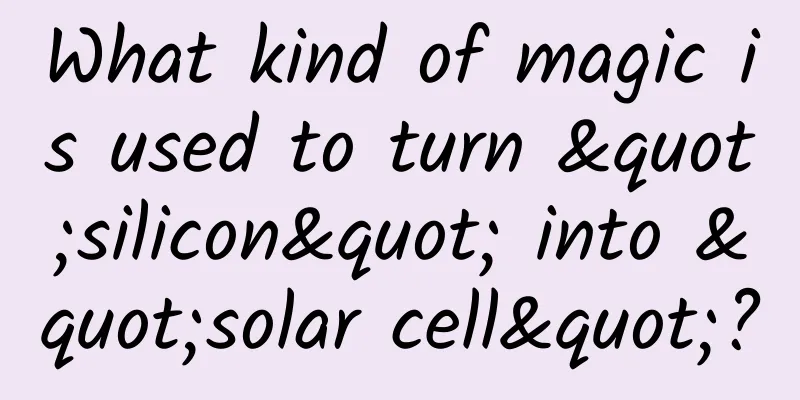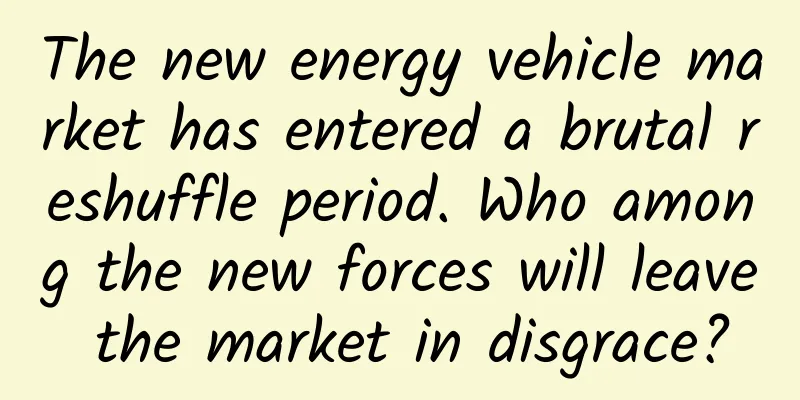What kind of magic is used to turn "silicon" into "solar cell"?

|
Produced by: Science Popularization China Produced by: Zhang Junda Producer: Computer Network Information Center, Chinese Academy of Sciences Renewable energy refers to energy that can be reused within a certain range. In other words, as long as the earth and the sun are not destroyed, renewable energy such as wind energy, geothermal energy, and solar energy are inexhaustible. Take solar energy as an example. The earth absorbs 173,000 terawatts of solar energy, which is 10,000 times the total energy used by humans on earth. We can’t help but wonder, will it be possible for human society to one day run entirely on solar energy? In fact, people have long been eyeing solar energy and trying to convert it into directly usable electricity. The dumbest way is to use sunlight to provide heat to boil water, and then use the steam from the boiled water to generate electricity. However, each energy conversion is inevitably accompanied by consumption, and the boiling water method is not efficient. Therefore, people fell into contemplation: How to directly convert solar energy into electricity? The man who first turned this idea into reality was Edmond Becquerel. Edmond Becquerel (Image source: Wikipedia) One day in 1839, Edmund, who was studying phosphorescence, discovered something incredible. He put silver chloride in an acid solution, connected two platinum electrodes, and then took it out to the sun. As a result, he found voltage between the two electrodes! At that time, people did not know the principle of this phenomenon, but only knew that light can generate electric potential, so they called this phenomenon the photovoltaic effect, or photovoltaic effect for short. Nowadays, most solar cells use the photovoltaic effect, so solar cells are also called solar photovoltaic cells. Currently, the most widely used photovoltaic cells are mainly made of semiconductor materials such as silicon. So how do people use semiconductors and the photovoltaic effect to make solar cells? The basis of everything: atomic band structure Simply put, energy bands refer to the different regions into which we divide electrons according to their energy. We all know that the nucleus is positively charged, which attracts negatively charged electrons, and the closer the electrons are to the nucleus, the stronger they are bound. Now we split the atom apart, the nucleus sinks to the bottom and the electrons are placed on top. In this case, we can divide the electrons into two active areas: one is the area close to the nucleus, where the electrons are tightly attracted, which we call the valence band. The other is the area far from the nucleus, where the electrons are not regulated and are relatively free. If there is an external electric field to make these electrons run, the material will conduct electricity, and we call this area the conduction band. In addition to these two regions, there is another region above the valence band and below the conduction band where electrons are not allowed to exist. We call it the forbidden band. The energy band structure of an atom (Image source: self-made by the author) This is the basic atomic energy band structure, but there are some details we need to pay attention to: First, the energy band can be further divided into different energy levels, and due to the Pauli exclusion principle, each energy level can only accommodate two electrons. Secondly, most atoms do not have that many electrons, and even the valence band is not full, and there are no electrons in the conduction band. Furthermore, the electrons in the valence band are not honest, and they may "go off the rails", that is, cross the forbidden band and rush to the conduction band. Of course, this process is called transition, and transition absorbs energy. Considering these three details, some readers may have guessed that there are two completely different types of materials in the self-heating world: one has a very narrow bandgap, or even no bandgap at all, and its outer electrons in the valence band can easily jump to the conduction band at room temperature, which is a conductor. On the contrary, if the bandgap of the material is very wide, generally greater than three electron volts (3eV), the electrons stay in the valence band at room temperature, then it cannot conduct electricity, which is an insulator. The band structure of different solids (Image source: Wikipedia) "Fickle" semiconductors Is there any material with an energy gap between the valence band and the conduction band less than 3eV? Yes, that is a semiconductor, which is usually a material with a conductivity between that of a conductor and an insulator. But the value of semiconductors is not reflected in their ability to conduct electricity, but in their "jumping" conductivity. The conductivity of semiconductors is easily affected by external factors and changed. Later we will see how the photovoltaic effect changes the conductivity of semiconductors. Next, we will take silicon atoms as an example to explore the mysteries inside semiconductors. 1. Structure of intrinsic semiconductor Semiconductors without any impurities, such as pure silicon and pure germanium, are called intrinsic semiconductors. Let's take a look at the silicon atom, which has 14 electrons, and the electron configuration is 2-8-4, with 4 electrons in the outermost layer. The properties of an element are mainly determined by the outermost electrons, so the outermost electrons of silicon have such a tendency: either find four more electrons to make four pairs, or throw away all four electrons. Silicon atom (Image source: made by the author) In a silicon crystal, each silicon atom has a silicon atom adjacent to it, and silicon happens to have four electrons in its outermost layer. It shares these electrons with its adjacent silicon atoms, so each silicon atom has a total of eight electrons in its outermost layer. Perfect! Silicon crystal covalent bond (Image source: made by the author) 2. Structure of impurity semiconductor What will happen if we dope some impurities into the intrinsic semiconductor? For example, if we replace one of the silicon atoms with a phosphorus atom, the phosphorus atom has 15 electrons, arranged in a 2-8-5 pattern, with 5 electrons in the outermost layer. After adding 8 electrons to the adjacent silicon atom, there is still one more electron. In this way, for every phosphorus atom doped, there will be an electron with nowhere to go. If too many impurities are doped, a "single electron army" will be formed. We call such semiconductors N-type semiconductors, and N (Negative) means that the electrons are negatively charged. N-type semiconductor (Image source: made by the author) On the contrary, if we add boron atoms, they have 5 electrons, 3 in the outermost layer. Boron atoms and the surrounding silicon atoms can only make 7 electrons. These 7 electrons are still one electron short of forming a stable structure, so a "hole" is generated here. We call it a P-type semiconductor, P (Positive) means that the hole can be equivalent to a positively charged particle. P-type semiconductor (Image source: made by the author) 3. Why do semiconductors conduct electricity? According to the previous statement, impurity semiconductors have free-moving charges and can naturally conduct electricity. So where do the free charges that allow intrinsic semiconductors to conduct electricity come from? In fact, under ideal conditions (absolute zero), intrinsic semiconductors cannot conduct electricity, and all valence electrons are bound to covalent bonds. However, the application of semiconductors is generally carried out at room temperature. At this time, due to thermal motion, the semiconductor will intrinsically excite a pair of hole electrons. Intrinsic excitation (Image source: self-made by the author) Of course, there are intrinsic excitations in both impurity semiconductors. That is to say, in N-type semiconductors, there are also holes, but the number is less than that of free electrons. Of these two types of carriers, the more numerous ones are called majority carriers, and the less numerous ones are called minority carriers. In P-type semiconductors, it is the opposite. Combination of N-type and P-type semiconductors: PN junction with "self-contained electric field" What happens if we connect two impurity semiconductors? N-type semiconductors have more electrons and fewer holes, while P-type semiconductors have more holes and fewer electrons. This is a bit like the mixing of two different solutions. The majority of electrons on this side want to run to the other side, and the majority of holes on the other side want to run to this side. This behavior is called majority diffusion, but this diffusion has problems from the beginning. I don’t know if you have played the game of "sticking bark". Two people need to "stick" together within a specified time. When the time is up, the person who fails to stick together will be eliminated. The same is true for electrons and holes. They cannot go far away, so the majority carriers at the junction of two impurity semiconductors are often directly "stuck" together. Remember that our two semiconductors are doped with atoms and are electrically neutral as a whole. We only draw the free electrons and holes on the conduction band, and there are atomic nuclei and inner electrons below. Now that the electrons have escaped or the holes have been filled, these two places will show electrical properties. The N-type semiconductor that loses electrons shows positive electrical properties, and the P-type semiconductor that loses holes shows negative electrical properties. This structure is called a PN junction. Does it sound a bit confusing? The following diagram can help you understand the formation process of PN junction intuitively. PN junction (Image source: Wikipedia) After the PN junction is formed, its two ends show different electrical properties, thus forming an electric field pointing from N to P. This electric field is formed spontaneously, and we can call it a self-built electric field. Now let's take a look at the situation of minority carriers. The electrical properties of minority carriers and majority carriers are opposite. Since the self-built electric field hinders the diffusion of majority carriers, it promotes the movement of minority carriers to the opposite side. This process is called the drift of minority carriers. When the diffusion of majority carriers and the drift of minority carriers reach a dynamic balance, the PN junction is stably formed. After a lot of preparation, we know why silicon is called a semiconductor, and why two semiconductors can be spliced together to form a structure with its own electric field - PN junction. After the preparation, it's time for the photovoltaic effect to appear! The final key step: shining light on the PN junction What happens when sunlight hits a PN junction? That's right, it's the photovoltaic effect. The photovoltaic effect is to "tempt" the already paired valence band electrons again and form electron-hole pairs again. In essence, the valence band electrons we mentioned earlier absorb the energy of light, become more energetic, and jump to the conduction band. Photovoltaic effect (Image source: self-made by the author) These electron holes are thrown to both sides under the influence of the self-built electric field, forming an electric field pointing from P to N. This is the photogenerated electric field, which is opposite to the self-built electric field. At this time, an external circuit is connected, and due to the existence of the potential difference, a current is generated in the circuit! At this point, our work of converting light energy into electrical energy through the photovoltaic effect and semiconductors is complete. Inside a photovoltaic cell (Image source: self-made by the author) Photovoltaic cells have been developed for nearly a hundred years, and the inorganic semiconductor photovoltaic cells listed in this article are the most mature type. In addition, there are some photovoltaic cells based on organic semiconductor materials, such as dye-sensitized solar cells and some perovskite solar cells. Regardless of whether they are organic or inorganic, the basic principles of these photovoltaic cells are inseparable from the various semiconductor-related theories we have introduced. Although photovoltaic cells based on these theories and materials have not yet reached their limits, the overall theoretical conversion efficiency is only 30%, and the actual conversion efficiency is difficult to reach the theoretical value. Now researchers have begun to explore photovoltaic cells based on new working principles, such as carrier solar cells, impurity photovoltaic cells, etc. They hope to increase the photoelectric conversion efficiency to 60% or even higher. We always have great confidence in the photovoltaic industry, which is still in its early stages. It may be an important option for humans to solve energy problems in the future. References: [1] Huang Haibin et al. Photovoltaic physics and solar cell technology[M]. Beijing: Science Press, 2019 |
>>: Online shopping scam prevention tips summarized by experienced poor people can save you money!
Recommend
Hu Xinshu vs. Papi Jiang, self-media selling itself to capital: one thought to heaven and one thought to hell?
If the first half of 2016 belonged to Papi Jiang,...
Xinxiang Mini Program Development Company, how much does it cost to make a film and television mini program?
Xinxiang Mini Program Development Company, how mu...
360, which is not short of money: Will it be the next video overlord?
After years of market cultivation and capital ope...
Toyota Brazil replaces CEO
According to Reuters, Toyota Motor announced that...
The egg yolk pie, a national snack and even a favorite of internet celebrities, has also collapsed?
Review expert: Wang Guoyi, Postdoctoral Fellow in...
Behind the accelerated herd effect of home appliances: the future path for manufacturers is becoming clearer
The more you argue, the clearer the truth becomes...
Guangzhou Distribution Mini Program Mall, how long does it take to produce a distribution mini program?
As of now, the number of mini programs has reache...
Lenovo launches 5-inch ultra-thin smartphone Vibe X with a thickness of 6.9 mm
[September 8 news] Recently, at the annual German ...
2022 Beijing Paralympic Winter Games schedule: What events are included? How many days will it be held?
The Winter Olympics have ended for some time, and...
After spending 5 million, I found out that this is how OCPC, the information flow advertising, works!
Nowadays, many lead-based advertisers are no long...
The calm before the outbreak? Comprehensive thinking about "Mini Programs"
Since WeChat announced the upcoming release of Mi...
Baidu Aicaigou bidding ranking rules
First, let’s briefly talk about the two ways of B...
While promoting the app, the daily activity is decreasing?
This time, I will mainly share some strategies an...
How to use the 4 key points of the addiction model to design a community with high conversion rates?
Recently, I read a book called "Addiction&qu...









